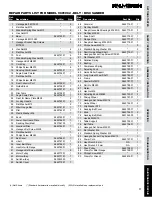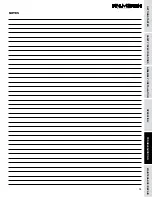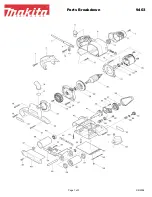
11
GETTING STARTED
SAFETY / SPECIFICATIONS
ASSEMBLY / INSTALLATION
OPERATION
TROUBLESHOOTING
MAINTENANCE / REPAIR
4. Do not force the workpiece into the sanding disc. Sand using
light pressure, letting the sanding abrasives time to do their
work!
5. Move your work piece slightly left and right on the disc,
keeping to the left-of-center, downward side. This will help
prevent resin or debris from building up on one area of the
disc, and also helps to prevent burning of the sanded surface
from excessive abrasive-action heat build-up.
Belt sanding
Dusty work environments may be
hazardous to your health. Always wear a
OSHA/NIOSH approved, properly fitting face mask or
respirator.
Always wear safety glasses complying
with U.S. ANSI Z87.1 before beginning any
sanding operation.
Make sure all disc guards are in securely
in place before starting the disc sanding
machine. Never operate the machine without the guards.
Always ensure the sander is turned off
and unplugged prior to attempting any
assembly, installation or changing of parts and accessories.
NOTE:
It is strongly recommended that users employ a
dust-collection system when using this machine. Use of
a dust mask or respirator is still required, even when
using a dust collection system.
1. Depending on what type of sanding that you will be doing,
set the Sanding Belt Table to the proper angle from 45° to
90° with a protractor, or other angle measuring tool or pre-cut
sample.
2. Once the table has been set for the correct sanding angle,
and all fasteners and handles are secure, the machine can
turned on.
3. Use the Miter Gauge for added control of the work piece
during sanding. The miter gauge can also be set to various
degree angles for maintaining accurate angles when sanding
small or multiple parts.
4. Do not force the work piece into the sanding belt. Sand using
light pressure, letting the sanding abrasives time to do their
work!
5. Move your work piece slightly left and right on the belt. This
will help prevent resin or debris from building up on one area
of the belt, and also helps to prevent burning of the sanded
surface from excessive abrasive-action heat build-up.
Platen
adjustment
hex screw
Platen
Figure 17
6. The Platen (#67) supports the back of the sanding belt and
offers a flat surface to sand or sharpen against. It should be
positioned so it is almost touching the back of the sanding
belt.
7. To adjust the platen, loosen the hex Screw (#7) at the rear of
the platen as shown in figure 17.
8. The platen can also be removed for contour sanding or
polishing.
Adjusting the sanding belt tracking
Always ensure the sander is turned off
and unplugged prior to attempting any
making any adjustments.
Tracking
adjustment
knob
Drive
wheel
1. Belt tracking on the center of the drive wheels is pre-set at
the factory. If an adjustment needs to be made, the sander
must be turned on.
2. Slowly turn the Belt Tracking Knob (#61) to correct the
tracking of the belt - left or right as needed - so that the belt
finally rides on the center of the guide wheel (#72).
Adjusting the sanding belt tracking
1. Remove the plastic Cover (#74) from the frame by
unscrewing the two knobs (#75).
2. Tilt the sanding belt table forward to 45° so that there is
ample space between the platen and rear of the table to
remove the belt.






































